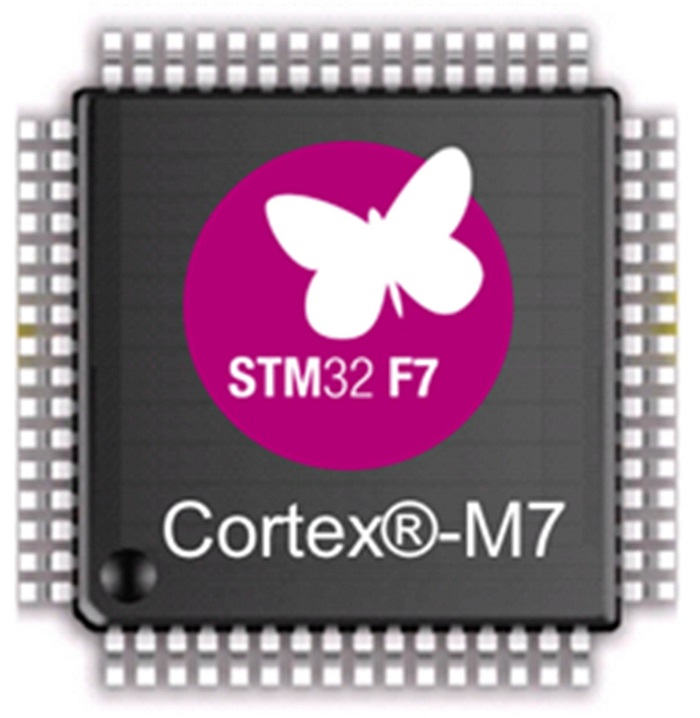STMicroelectronics, the global semiconductor leader and leading supplier of ARM Corex-M core microcontrollers, recently extended its STM32 family of more than 500 pin- and software-compatible microcontrollers to include the STM32 F7 microcontroller.

Right off the bat, there are a lot of great things to point out about this particular series. For one, it leverages the ARM Cortex-M7 core, ARM’s newest and most powerful Cortex-M processor to date. As a result, the STM32 F7 offers up to twice as much processing and DSP performance than the industry’s previous leader, ST’s very own STM32 F4.
Fortunately, given the fact that both MCUs come from the same company, professionals looking to upgrade to the newer MCU will be pleased to note they can do so seamlessly.
Some other things worth noting about how the STM32 F7 utilizes the strength and speed of the Cortex-M7 core:
• AXI and multi-AHB bus matrix for interconnecting core, peripherals and memories
• Two general-purpose DMA controllers and dedicated DMAs for Ethernet, high-speed USB On-The-Go interface and the Chrom-ART graphic accelerator
• Peripheral speed independent from CPU speed (dual clock support) allowing system clock changes without any impact on peripheral operations
• Even more peripherals, such as two serial audio interfaces (SAI) with SPDIF output support, three I²S half-duplex with SPDIF input support, two USB OTG with dedicated power supply and Dual-mode QuadSPI Flash
• Large SRAM with a scattered architecture:
– 320 Kbytes of universal data memory, including 64 Kbytes of Tightly-Coupled Memory for Data (DTCM) for time critical data handling (stack, heap…)
– 16 Kbytes of Tightly-Coupled Memory for Instructions (ITCM) for time-critical routines
– 4 Kbytes of backup SRAM to keep data in the lowest power modes
• Power efficiency
STM32 F7 MCU series operates at frequencies up to 216 MHz; it also uses a 6-stage superscalar pipeline and Floating Point Unit (FPU) to produce up to 1082 CoreMarks1. In terms of improvements made to the MCU’s architecture: STMicroelectronics has included two independent mechanisms to reach 0-wait-state performance from both internal and external memories.
Specifically, this MCU uses ST’s Adaptive Real-Time (ART Accelerator™) for internal embedded Flash and L1 cache for both execution and data access from internal and external memories.
There are several other reasons why the STM32 F7 MCU series is worth considering:
1. Great Investment: Pin-to-pin and code compatible with not only the STM32 F4, but the entire STM32 Ecosystem
ST’s advanced, future-proof architecture allows the company to reach 2000 CoreMark on the next technology node with a fully backwards compatible product
2. Smart architecture: STM32 F7 architecture is done so in a way to realize the potential intelligence of ARM® Cortex®-M7 and the STM32 peripherals
3. Performance: STM32 F4 = 608 CoreMark, STM32 F7 = 1082 CoreMark
More math's, more signal processing = Up to 2x DSP performance vs STM32 F4 series
4. Power Efficient: Boosts performance, but does not compromise on power efficiency
5. Innovation. Answering the embedded developers for ever more powerful peripherals, more In–Out throughputs, unlimited memory space for more creativity and user experience
And in terms of real world application:
GP MCU
Offer continuity to MCU customers looking for higher performance and integration
Key features:
Large memory, new core, rich peripheral set
GP DSP
MCU customers can replace DSP with a standard core
Key features:
Advanced mixed signal with high computation capability, large memories, peripherals, cost
GP MPU
Customers can replace MPU and MCU in control+HMI applications
Key features:
High performance, advanced control peripherals, graphic, Quad SPI
Learn more by checking out this video on the STM32 F7
To learn more about the STM32 F7, or to order this MCU, please visit the STMicroelectronics page at DigiKey
Advertisement
Learn more about STMicroelectronics





